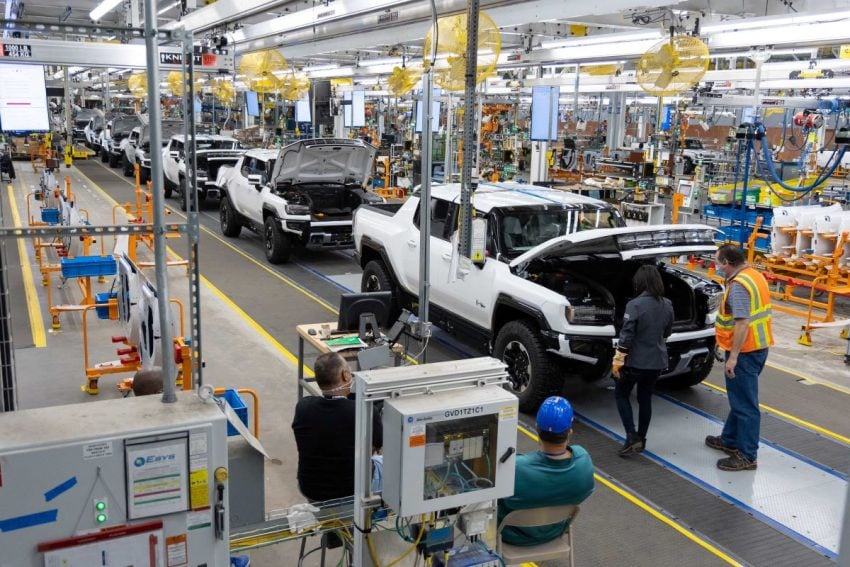The automotive industry is in the midst of a large-scale transition to all-electric propulsion systems, arguably the biggest change to face carmakers in roughly a century. To make that transition a reality, carmakers are racing to make investments to not only assemble these new electric vehicles but also provide the necessary parts to do so. That said, many fear that the EV transition will result in plant closures and job losses, given the mechanical simplicity of all-electric vehicles compared to ICE-based vehicles. However, according to a new report, the American car manufacturing footprint is unlikely to change before the end of the decade.
According to a report from Automotive News, which cites an analysis from the Federal Reserve Bank of Chicago, the auto industry’s manufacturing footprint in North America is expected to remain largely unchanged through 2029.
As it stands, automakers have invested around $250 billion into the North American battery and EV supply chain. According to the Department of Energy, the flood of investment began around 2021, with several major new plants popping up around the country focused on electric vehicle production. Among these are Ford’s BlueOval City in Tennessee and Hyundai’s Metaplant in Georgia. Honda has also opened a new battery plant in Ontario, Canada.
Meanwhile, GM revamped its Detroit-Hamtramck plant in Michigan for EV production, renaming the facility Factory Zero and opening the company’s first EV-dedicated production facility. Further investments include billions of dollars for the GM Orion Assembly plant, the GM Spring Hill plant, and several brand-new battery production facilities in partnership with LG Energy Solution, among many other investments, all in support of the electric vehicle transition.
With many new plants created and several existing plants adapted to handle the production of vehicles with a variety of propulsion systems, automakers aim for flexibility to meet fluctuating demand for electric vehicles. The Chicago Fed’s analysis indicates that the geographical distribution of vehicle assembly plants, concentrated in regions like the northern corridor (Illinois, Indiana, Michigan, Ohio), southern corridor (Alabama, Georgia, Kentucky, Mississippi, North Carolina, South Carolina, Tennessee), and Mexico, will remain stable. Despite the transition to EVs, the analysis predicts that light-vehicle assembly plants in North America will see minimal closures.
Additionally, automakers’ ability to produce ICE, hybrid, and electric models within the same facilities will nearly double by 2029, allowing automakers to adjust to market demands without relocating plants. Finally, the Inflation Reduction Act and labor contracts with UAW and Unifor are expected to bolster North American battery production, ensuring that assembly plants remain operational through the decade.
Subscribe to GM Authority for more GM electric vehicle news, GM business news, GM production news, and around-the-clock GM news coverage.


















Comments
mmm that transition has seen more back pedaling headlines than new EV assembly plant and new EV hires headlines.
Delays of release does not necessarily stop contruction which must get done to produce!
I didn’t say delays. I said back pedaling. Every major automotive manufacturer has done a 180 on their commitment to EVs. massive revised EV sales forecasting, and renewed commitment to ICE development.
Funny HOW THEY JUST DONT GET IT. THEY KEEP PRODUCING THESE WASTED SPACE EVs AND THEY KEEP SITTING ON THE LOTS NOT SELLING. SOMEDAY SOMEONE WITH A BIT OF INTELLIGENCE WILL WORK IT OUT THAT THE MAJORITY OF PEOPLE DO NOT WANT A PART OF THIS FORCED EXPERIMENTAL RUBBISH.
Look at how many article from the time of your comment until now that GMA has posted about EV clawbacks lol
Most will transition into bankruptcy.
How about the resale value keeping people from throwing there money away for used EV’S. Chevy Bolt 2021 with only 4,000 miles selling at a dealer for only $15,000. Seller couldn’t have gotten very much for it. Just throw it away when your done.